CONFIGURING THE SWITCH
Class of Service Configuration
Class of Service (CoS) allows you to specify which data packets have greater precedence when traffic is buffered in the switch due to congestion. This switch supports CoS with two priority queues for each port. Data packets in a port’s
You can set the method used to process priority traffic (i.e.,
Field Attributes
•First Come First Served – Packets are processed
•All High before Low – All packets in the
•Weighted Round Robin – Sets the preference given to packets in the
•Enable Delay Bound – Limits the queuing time for
(Range:
•QoS Policy (High Priority Levels) – The default priority levels are assigned according to recommendations in the IEEE 802.1p standard. However, you can map the priority levels to the switch’s output queues in any way that benefits application traffic for your own network. (Range: Level 0 - 7; Default: Level 4 - 7)
Web – Click Administrator=>Switch Settings=>Advanced. Select the priority method (First Come First Serve, All High before Low, or WRR), set the
